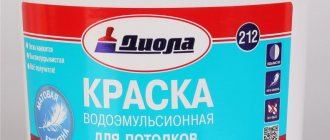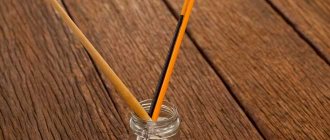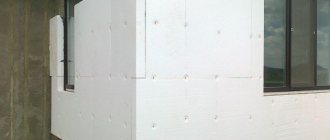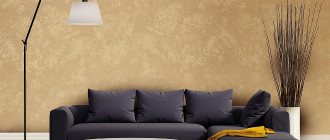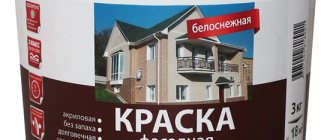For more than half a century, acrylic paint has been used for renovation of premises for walls and other surfaces, including ceilings. This material is environmentally friendly and suitable for various interior works, in particular for painting walls or ceilings. The budget does not always allow for expensive repairs; in this case, acrylic paint for walls and ceilings is perfect. But before applying acrylic paint to a wall or ceiling, you should carefully prepare all the necessary surfaces; if all the work is done correctly, the coating will last for many years.
This material is environmentally friendly
Acrylic paint composition
The material has a synthetic base, with a polymer emulsion that binds pigment and water. But these components are not enough for complete protection in the finishing. Therefore, various additional components are introduced into the composition, which can protect the painted surface from many factors.
In addition to the pigment, the composition contains a stabilizer and coalescent; all these components add additional characteristics that help preserve painted surfaces for a long time, making application convenient. The type of use of acrylic paint directly depends on the composition. Additional ingredients easily allow the emulsion to be used for outdoor work, including in places with high moisture, painting metal surfaces, protecting it from corrosion, and the presence of additives, such as a fungicide, is necessary when painting on wooden surfaces.
- When decorating the exterior of a facade, you should choose a paint that contains an insecticide. This additive will protect the building from damage by insects for a long time.
- When decorating the interior of rooms, painting is always done from the ceiling to avoid unnecessary drops on the walls and floor.
The material has a synthetic base, with a polymer emulsion that binds pigment and water
Coloring instructions
Before applying the emulsion, it must be diluted with water or a special liquid. Typically, manufacturers indicate proportional ratios on the container. For uniform mixing, it is better to use a construction mixer. It is advisable to dilute it in a separate container, and close the rest of the product tightly.
When opening the package, it is better to remove the resulting film, since when mixed later it will form lumps, which will subsequently lead to uneven application.
For even mixing, it is better to use a construction mixer.
Ceiling preparation
- Apply a thin layer of putty to the surface.
- Using sanding material, remove any existing irregularities.
- Remove any accumulated dust.
- Apply primer liquid with a roller.
After the preliminary work, you can begin the main tasks.
By the way. If the surface is well coated with a primer, then much less material will be needed.
Application
- Dip the roller in a special tray filled with acrylic paint. Roll it well so that it lays evenly.
- You need to start applying acrylic paint from the corners. One layer is applied.
- Allow the material to dry completely, only then apply the second layer.
Advice. If the first layer was applied across the room, then the second must be applied along the surface of the room.
After both layers have been applied and dark spots become visible, they are removed using sandpaper and light sanding. It is worth remembering that such defects cannot be painted over.
If black spots appear on the wall, they can be removed with sandpaper
Peculiarities
Acrylic paint can be matte or glossy. But for painting the ceiling, matte is more used, while glossy is used for painting walls. When applied, it is matte and looks velvety on the surface, thereby hiding minor inaccuracies and defects.
The glossy finish, on the contrary, shows all the visible irregularities.
Acrylic paint for walls and ceilings is used very often in decoration. It has earned its popularity for its versatility, and it is also perfectly applied to concrete and wood surfaces.
The material must be used carefully, since acrylate releases minor harmful substances, despite the fact that acrylic paint contains a water-based emulsion. When applied, the room should not be colder than -5. The emulsion is easier to apply with a roller than with a brush.
Acrylic paint for walls and ceilings is very often used in decoration
How to choose the right composition
If necessary, water-dispersed acrylic paint is easily diluted with water.
To independently choose a coloring composition that will create a durable and high-quality coating, you should listen to the advice of builders and designers:
- To paint a living room, office, children's or bedroom, you can buy water-based or water-dispersion paint without any additives. This material creates a breathable coating, dries quickly, and does not release harmful compounds into the environment.
- For rooms with high humidity - bathrooms and kitchens - it is advisable to choose acrylic compositions with the addition of latex or silicone. The presence of these components will provide the coating with resistance to moisture, splashes, drops of water and detergents. The same type of paint is recommended to be applied in hallways and corridors. In these rooms, the walls have to be washed frequently, as they become dirty from constant contact with outer clothing and street shoes.
When choosing an acrylic-based paint and varnish material, you need to consider not only its type, but also its purpose:
- To paint interior walls and ceilings, you need to use interior paint (for interior work).
- House facades, external and internal walls of unheated utility buildings, garden sculptures and other architectural forms should be painted with compounds for facade or exterior work.
Manufacturers offer a rich palette of shades. But if the color of the finished product is not suitable for the design of a kitchen, bathroom or living room, you can buy white water-based paint and tint it in one color or another. Almost all companies and stores selling building materials provide tinting services for paints and varnishes.
You can give the suspension the desired shade yourself - just purchase a coloring pigment and mix it thoroughly with the white base. Experts advise adding color in small portions until the mass is painted in a shade that matches the design intent. The final color of the painted surface depends on the degree of initial whiteness of the coloring composition.
According to the level of whiteness, acrylates are divided into 3 categories:
- super white;
- white;
- milky white.
Super white paints give a shining, snow-white shade, so they are better suited than others for painting ceilings or tinting. When buying paint and varnish material, you should make sure that the inscription on the container corresponds to reality.
To avoid a discrepancy between what is indicated on the packaging and the actual shade, before paying with the seller, you need to compare the color of the suspension with stationery paper (you can take an A-4 sheet with you to the store or to the construction market).
There is another type of acrylic paint - structural, or texture. It can be applied to external and internal walls, and used to protect surfaces exposed to climatic and mechanical stress.
With the help of available materials and construction tools, on a freshly painted surface, you can create an imitation of finishing from various materials: concrete, natural stone, natural leather, wood eaten by bark beetles, etc.
Matte acrylic paints are most often used for painting walls in bedrooms and children's rooms.
Gloss or matte finish
When applied to walls and ceilings, acrylic compounds can form a matte or glossy finish. Matte paint will create a warm, cozy atmosphere, visually expand the space, give the surface a velvety texture, and hide minor defects. However, stains of dirt and grease will be clearly visible on a matte wall, so it will have to be washed frequently.
Glossy paint and varnish material will make the walls shiny and the interior presentable. It will mask traces of splashes and water drips, but will reveal all the unevenness and roughness. Before applying such a composition, you will have to carefully prepare the base and remove the slightest defects. But it will be much easier to care for a glossy wall than a matte one.
Advantages
- It contains toxic components.
- Dust does not settle on the surface painted with acrylic water-based paint.
- Acrylic paint also perfectly protects the surface from various bacterial fungi.
- Drying within one hour.
- Ceilings and walls painted with acrylic paint are more resistant to ultraviolet radiation.
- Not afraid of moisture, easily tolerates wet processing.
- If necessary, you can create your own shade by adding color.
Acrylic paint has many advantages
Pros and cons of interior acrylic wall paint
Acrylic paints appeared on the construction market about fifty years ago, and they became popular among buyers only recently. Recently, this material has been used quite often during the renovation of premises in Moscow. As we have already said, such a finishing coating can bring to life the most daring design solutions of our time. Most often, ceilings and walls of rooms are covered with acrylic paints. In some cases, interior acrylic wall paint can be applied directly to brick or concrete surfaces.
What are the advantages of interior acrylic wall paints:
- Pollution resistance. The water-based emulsion can be washed, and the high density of this material allows you to hide some defects in the base (up to 5 mm deep) if you apply the paint in several layers.
- Durability of the coating. Acrylic paint practically does not fade in the sun.
- Surfaces coated with this paint are resistant to high humidity. This material can be used to decorate any premises.
- Heat resistance. You can safely use interior acrylic paint to decorate the walls and ceilings of a kitchen or any industrial space - this material is not afraid of high temperatures.
- Such water-based coatings completely lack the unpleasant odor for which many other coloring compounds are famous.
- Interior acrylic wall paint dries quickly, after which its color can become much brighter. Keep this in mind when choosing the right color correctly.
- This is an inexpensive material due to its composition: all its components are affordable.
- A variety of colors of acrylic coating allows you to implement all kinds of interior design ideas.
Interior acrylic paints for walls have many advantages. Reviews about them are most often positive. Currently, the demand for acrylic is very high. But this material still has its drawbacks. You need to find out what exactly its negative aspects are before you go shopping.
The disadvantages of acrylic coatings are the following:
- such a coating quickly becomes dirty and colonized by dangerous microorganisms;
- This paint cannot be washed off with water once it dries. You need to take this into account and often rinse the working tool while working;
- acrylic paints cannot be dissolved with water in proportions greater than 1 to 10. To do this, you need to use special solvents, which should be indicated in the instruction manual.
When comparing, for example, interior acrylic and latex wall paints, it is obvious that they are different in their chemical composition and basic physical characteristics. For example, the latex present in the coating makes it especially durable and elastic. Although the average consumer is unlikely to notice these nuances.
Variety and choice
Glossy
Gloss gives any surface shine and an appropriate shade, but in order to cover it you will need an almost perfect surface, because it shows all the defects.
Matte
The matte variety is more likely to be classified as universal; it is more durable and does not fade over time, maintaining its original appearance.
Acrylic paint is divided into several types according to color
Mother of pearl
This is a special type and contains an inorganic filler. When applied, it forms a visual relief.
Water-based
These are all paints that contain water, and those that do not contain water are perfect for outdoor use.
When choosing a paint material, first of all you should pay attention to the manufacturer, and then to the durability of the selected material.
When choosing a paint material, you should first pay attention to the manufacturer
Where and how is interior acrylic paint used?
Since acrylic paint can be easily applied to any surface, this material is widely used in various fields. In addition to covering ceilings and walls inside rooms, it can also be used to paint building facades. Of course, the composition of materials for exterior and interior decoration is different. To paint heating radiators or stoves, you will also need a special mixture that must withstand elevated temperatures. Before using the paint, be sure to read the instructions that come with it.
So, when choosing interior acrylic paints for walls, you need to pay attention to which surfaces they are intended for, because the material may have a different composition:
- for indoor work;
- for painting building facades;
- especially resistant paint.
Interior acrylic wall paints have excellent water-repellent properties. This makes it possible to use them for finishing bathrooms and kitchens, along with bedrooms and living rooms. But still, these coatings are not suitable for areas that will be constantly wet from splashing water. It is better to protect such surfaces with tiles. Painting with acrylic paints is only allowed on those walls of the room that are usually dry.
Recommended articles on this topic:
- Arrangement of a small apartment
- Stages of renovation in an apartment
- Turnkey cosmetic repairs
Interior acrylic paints for walls can be used to cover surfaces made of concrete or brick, as well as those made of wood or cinder block. If you want to save money on apartment renovations, choose the following inexpensive coatings:
- vinyl acrylic;
- styrene acrylic;
- acrylic silicone.
These types of interior acrylic wall paints contain copolymers. There are many other types of acrylic that are suitable for any given occasion.
What else is notable about acrylic coating? It can be used even if there are minor defects on the surface. No foundation preparation is required. Small irregularities up to 0.5 cm deep will be virtually invisible after applying the coloring composition.
Manufacturers
- Tex. Painting with this material is suitable for those who have a small budget. Has excellent moisture resistance.
- Dulux. The material has antibacterial properties and is suitable for painting children's rooms. Suitable for concrete and wood surfaces.
- Tikkurila. This company produces higher quality and more expensive material; manufacturers recommend applying only one layer.
- Caparol. Durable to wear, but expensive.
- Sniezka. High quality, used for interior and exterior work. Water-dispersible paint has a hypoallergenic effect. Waterproof and wear-resistant. Cost is related to quality.
Painting with this material is suitable for those who have a small budget.
Painting ceilings and walls with acrylic paint is not the easiest process. To get an even layer without streaks from application, you need to prepare the surface well and select the right consumables.
Before you start painting, clean the surface of any dirt. Fix all kinds of cracks and holes with putty. Apply the primer with a roller, and sand the area treated with putty to remove any unnecessary irregularities.
Before painting, thoroughly clean the surface
When using a brush, you can hide minor defects on the surface, which will further improve the quality of the work performed.
To avoid divorces, you need to follow the following recommendations.
- Wait until the previous layer is completely dry. If this is not done, stains or stains may form.
- Small cracks are best painted over with a brush.
- Foam rollers are not the best option.
- The second layer must be applied in a different direction to avoid defects.
To avoid divorces, you should follow the recommendations above
Characteristics of paints
When choosing a decorative coating, it is necessary to take into account the conditions of its operation. The mechanical impact on the ceiling, floor, walls or doors is different, and accordingly the resistance to abrasion and washing will vary.
- Quality indicators include: homogeneity of the mixture, absence of inclusions of a different color, iridescent film, peeling, particles of debris and dust. It is checked visually when opening a bucket or jar.
- There are 6 categories of resistance to abrasion and mechanical stress. Non-resistant category 6 is suitable for ceilings and non-critical areas of walls, categories 3 and 2 are washed with the addition of chemicals using a sponge and brush, and category 1 is suitable for painting the floor, doors and critical areas of the kitchen wall.
- Vapor permeability allows the wall to breathe and not accumulate excess moisture inside the room.
- Moisture resistance will ensure the safety of the surface from splashes of water and other liquids.
- The viscosity of the mixture affects the consumption of the material; hiding power characterizes the ability of the paintwork material to cover the original color of the material. Usually this is one or two layers.
- The degree of gloss of the film depends on the preferences and characteristics of the room; there are five levels from deep matte to glossy.
Painting a wooden ceiling
Acrylic paint can be safely used on wooden surfaces. The material is non-toxic and flame resistant.
In order for the wooden surface to be painted well, it must be thoroughly cleaned of dirt.
When selecting a material, you need to look at durability. Degrease the desired surface and impregnate it with impregnation, this will prevent the impact of negative factors.
In order for the wooden surface to be painted well, it must be thoroughly cleaned of dirt.
Wood painting works
- Dilute the paint if it is concentrated.
- Paint one layer, correct any defects with a thin brush. In such cases, the roller should not be used.
- Apply a second coat.
- Allow the second layer to dry; if stains form, lightly sand them.
For painting on wood, follow the technology above
Acrylic emulsion and wall painting
For painting walls, it can be used in any weather conditions, and it is possible to paint not only interior walls, but also the facades of houses.
To create an original author's drawing, not only simple acrylic paints are used, relief pastes are also used. For street art, paint is mixed with a special liquid. After completion of the work and complete drying, the applied paint does not peel off from moisture that has entered it and does not form cracks. The painting will last for many years without losing its beauty.
To completely protect the wall painting and preserve it for many years, you need to apply a transparent matte varnish, which is based on acrylic.

